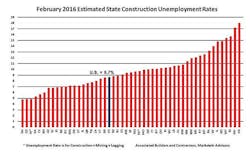February construction unemployment rates improve in 41 states from 2015
WASHINGTON, D.C. — Temperatures remained above normal for much of the country in February. However, precipitation rates were also above normal for much of the East and below normal for much of the West and parts of the South. These factors contributed to the not seasonally adjusted (NSA) construction unemployment rates for the nation maintaining a low February rate of 8.7 percent, a slight rise from January's similarly low 8.5 percent rate. It was also the second lowest February national construction unemployment rate going back to the beginning of the series in 2000, surpassed only by the 8.6 percent rate in February 2006.
The NSA construction unemployment rates for the country and 41 states were lower than in February 2015. February's 1.9 percent year-over-year improvement continues the streak of year-over-year NSA construction unemployment rate declines dating back to October 2010. On a year-over-year basis, February national NSA employment in construction increased by 253,000.
Note that the NSA unemployment rates have a seasonal pattern with the national NSA construction unemployment rate often increasing from January to February. However, 22 states posted a decrease in their rate from January and two states (Florida and Kansas) had no change in their rate.
View states ranked by their construction unemployment rate (pdf).
View states ranked by their year-over-year improvement in construction employment (pdf).
The Top Five States
The five states with the lowest construction unemployment rates in February in order from lowest rate to highest were:
1. Georgia
2. Colorado
3. Hawaii*
4. Virginia
5. Texas
* Unemployment rate is for construction, mining, and logging combined
Four states—Colorado, Georgia, Texas and Virginia—were also among the top five in January. Georgia, with a 4.8 percent estimated construction unemployment rate in February, had the lowest rate for the third consecutive month.
Colorado and Hawaii came in a close second with a 4.9 percent construction unemployment rate. Posting a one percent decline in its construction unemployment rate from January, Colorado improved from third lowest that month. Hawaii also experienced a drop in its rate from January—down 1.5 percent, the third largest monthly decline among the states. That moved Hawaii up from the sixth lowest rate in January, tied with North Carolina. Hawaii also had the second largest year-over-year drop in its rate, down 4.5 percent.
Virginia saw a reduction in its construction unemployment rate in January from 6.1 percent rate (based on revised data) to 5.3 percent in February. That left the state with the fourth lowest rate for the second month in a row.
Texas slid from second lowest in January to fifth lowest in February with a 5.7 percent construction unemployment rate. South Carolina, which had the fifth lowest rate in January, fell to seventh lowest, tied with Arizona with a 6.8 percent rate.
The Bottom Five States
The five states with the highest construction unemployment rates (from lowest to highest) were:
46. North Dakota
47. Wyoming
48. Rhode Island
49. West Virginia
50. Alaska
The five states with the highest estimated construction unemployment rates in February were the same as in January although some of the rankings changed.
As would be expected given that these are NSA rates, Alaska with an 18 percent rate in February had the highest rate for the sixth consecutive month. February's rate was down 1.9 percent from Alaska's January rate of 19.9 percent (based on revised data). A reduction in the February rate from January is somewhat common for Alaska, which has experienced a decline in ten of the previous 14 years.
West Virginia, with a 17.2 percent construction unemployment rate, had the second highest rate. In January, the state had the third highest rate based on revised data (previously reported as the second highest rate).
Rhode Island had the third highest February construction unemployment rate (15.7 percent). In January, the state had the fifth highest rate based on revised data (previously reported as tied with Illinois for fourth highest). The state had the largest year-over-year decline among the states in February (down 5.2 percent). The state has experienced improved construction activity for a number of months. As a result, the construction unemployment rate has fallen on a year-over-year basis each month starting in October 2014.
Wyoming had the fourth highest estimated construction unemployment rate for the second month in a row (15.4 percent). Its January ranking is based on revised data, previously reported with the sixth highest rate. No doubt reflecting the effects of the downturn in commodity prices in general and energy in particular, Wyoming had the largest year-over-year increase in its rate, up 5.5 percent.
North Dakota, another state suffering from the effects of the downturn in energy prices, posted the fifth highest construction unemployment rate in February, 14.9 percent rate. For the month, the state had both the second highest year-over-year increase (up 3.4 percent) and the second largest monthly decrease (down 1.7 percent). The monthly reduction in the state's February construction unemployment rate has been the norm for North Dakota going back to 2001. Over most of this period, this was due to increased construction activity and, consequently, increased employment. This time, it is likely due to unemployed construction workers leaving the state for better prospects elsewhere.
Read more on ABC's website.

